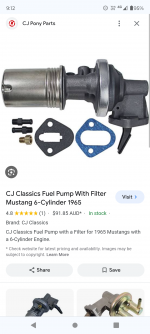Mr. Highlander
New member
Precursor
This is kind of an introductory post, as well, but I live in Denver, Colorado. I will start my story in September of 2022. I had a 1989 Lincoln Town Car that I was using as a daily driver. Some U-Haul truck tried to do a sudden U-turn (A bit of irony there...) in a busy street, and I was the victim that couldn't stop. By the way, my friend and me were fine, the Luxo-Boat saved us. I always loved the soft mushy ride of these cars, and their shear size. The latter proved life saving. So I set out trying to find another one for a good deal. I paid $2,800 for the Lincoln with 150,000 miles on it. So was hoping to find a good deal like that. So I found a 1973 Mercury Marquis in Grand Junction (200 or so miles away) for $3,500 with 110,000 miles. So my friend (same as above) and me drove to Grand Junction, and picked up the car. It was a great car, smooth reliable (Carburetor excepted). Until about a year and 27,000 miles later (July of '23) and when the transmission pump seal failed, the engine blew a head gasket, and gas became more expensive. So in a complicated month long ordeal involving a dud 460, re-headgasketing the 429 (ended burning oil after, and blew the HG again), and torque converter seal replacement that didn't work, I didn't know what to do. So I sat and thought about. changing the engine driveline. I needed something reliable, something with economy, and something with serviceability. Speed doesn't really appeal to me as long as I can do on the highway. I was going to look into an Inline 6.
The Beginning
I first needed to confirm it was going to fit with some modifications. After confirming the transmission cross member could be moved up to accomodate a C4 transmsission, I set on the search for an inline. I was looking for the 240 or 300 engine. I checked on Facebook market place, and I found a 200CID from a '65 Mustang. It had only 40,000 Miles on it, and was selling for $1000. The seller had a C4 transmission out of the 'stang too, but he sold it. So I found a C4 from a 81 Mustang with a CID in Laramie Wyoming, from a radiator shop, for only $350. It was described as "In working Condition". The engine seller was on the way down, so me and my friend (again, same one) picked them both up same day. I negotiated the engine down to $900, and the transmission down to $300. The cost of the negotiations were offset however, due to the fact that the bellhousing and torque converter would not bolt up. Ford decided to throw a wrench in the typical thinking process, and used a bigger pattern for 80-83. I ended up using a bellhousing and a remanufactured starter from a '78 Fairmont, and a remanufactured TC. Also I replaced the TC seal and the slip yoke seal. I also had to get a custom Aluminum driveshaft. That was nowhere near cheap.
The Process
First, I had to change the front coil springs. I wanted the same soft quishy ride. The OEM ones are rated at 470 Lb-per-inch. So I subtracted the 429 weight with the 200 weight. I got a difference of 270 Lb. I divided that by 2, (number of coil springs in the front), and got 135. I took that number off from 470 and got 335. So I had to find coil springs with a spring rate of 335 Lb-per-inch. After looking on Rock Auto, I found that Ford has one height and length of springs for their full sized cars. Compressed height is 12 inches, with a diameter of 4 inches. Only the rates change, depending on car. So by looking up a car an engine with a light engine (For example, 1972 Ford Custom with the 240 engine). They specified a spring rate of 318 without the heavy duty suspension. Close enough. A 240 is heavier than a 200, by quite a bit. But a Mercury Marquis is heavier than a Ford Custom (Longer wheelbase). So I thought it would compensate pretty well. Next on the agenda was finding a transmission mount. Again, this was pretty straight forward. I just found a mount that was used in a full sized Ford with a C4. I am sure the old transmission mount would do, but it was baked after 50 years. Some sources say that C4 mounting hole distance and C6 mounting hole distance are different. I can confirm this is not true. They are the same. The only difference between the mounts is the height, which is different. The shift linkage was different between the two transmissions however. The column shift trannys had the lever facing down, and the console shift was facing up. I just used some scrap aluminum to make an adapter between the two. It also doubled in making a mount for the ICM. The engine mounts were less straight forward. I had to experiment with these. I had a wild scheme about using 2 OEM 200CID Mustang mounts on each side. That didn't work to make a long story short. So after that failure, I looked at what Chrysler was doing in their cars. What made me look at them, was that their motor mounts were simple. So I make 4 brackets, 2 for each side. It worked beautifully.
Performance
I wanted (More like needed) to pep up the performance of the 200. The Load-O-Matic system seemed like a real boggy dog. So I kinda did the typical mod, and changed out the Autolite 1100 for a rebuilt RBS from a '73/'74 Gran Torino w/ 250 engine. Modified the air cleaner so it would fit on the carb. Also changed out the distributor out for a Duraspark II. To accommodate all the vacuum hosed, had to use expensive fittings from Advanced Auto. I used the oil pressure switch from the 429. I like using the lights. (I had replaced it one time before so it was relatively new). More on the temperature switch later...The exhaust manifold opening was pretty small at 1 3/4 inches. I wanted a little bit of more flow, So I got a 2 inch one off of EBay. I didn't need the dual exhaust. Just something simple. I changed the thermostat and the housing. I wanted to make things simple, so that a 1.5 inch diameter hose was used across the car. For the throttle cable, I bought one off Autozone, for a 1992-6 Ford F150/250. It was long, just what I needed. And it fit too! Amazing! Got to hand it to Ford for making it relatively simple. One thing that wasn't was the PCV valve. I had to add one, because they had to use the crankcase down pipe.
Getting it started
So it was time, after 2 months, after getting everything planned out, and installed (Suspention was a PITA, with replacing stuck ball joint and crusty rubber bushings). It was at the end of October, and we just got our first snow storm of the year. It was 20 degrees out, and I didn't put the muffler in yet. So I got it cranking and it finally started. Loud, loppy, but started. I noticed that the temp light came on. The folks at Autozone gave me the wrong temp light. So I got one that would turn on at 210 degrees from American Volt, here in Denver. Later that week, I got the cooling lines for the transmission in, the exhaust, and tranny filled. it was ready to rock and roll. I started it, and put it in gear, hoping for the best, but expecting the worst. To my delight, the car started rolling, and I was off. I took it for a midnight spin. It drove great. Not bad for a $300 tranny, I must say! I drove it for a week. The biggest issue was the temp of the engine. The light kept turning on on the highway. It wouldn't over heat, but it would get hot. I finally tracked it down to the water pump. Almost 60 years of sitting isn't kind to a Water pump. The darn thing had more more rust than not. So after replacing it, it cools fine. No lights. Radiator is warm to touch, but not hot. Second issue was a hesitation. Autoline sent me a rusty carburetor. After rebuilding it, it runs fine.
Conclusion
After 2 weeks and over 1000 miles put on the car, I would call it a success. Under normal driving, the transmission shifts around 2000RPM. The engine can rev to 4000. Never tried any farther (Nor do I want to.) The Highway on ramp is interesting. The car goes 0-60 in 17-18 seconds. You kinda have to put in in first, go to 40, put it in second, rev it to 60 and rest is third. It isn't fast, but I don't care. Its still the comfortable luxo-boat that it once was. So I guess My question is, was it too much car for such a small engine? Give me your honest to goodness thoughts! I am happy that I put such an engine in. It gets 17 MPG on average! It was a challenge, but loved it. Here are some photos:
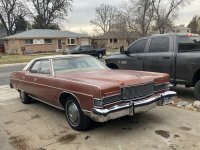
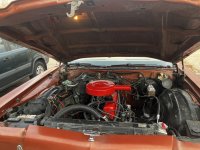
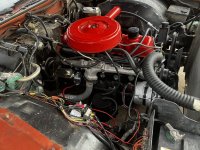
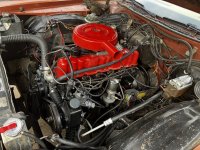
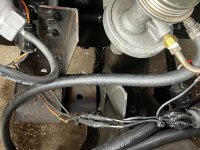
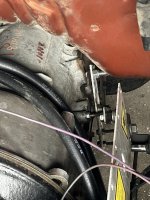
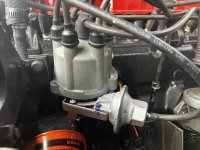
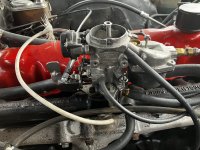
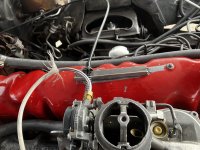
Edit, Here is the parts list, and cars used in the search bar/parts taken off of.
1981 Ford Mustang; 200CID
Transmission
1978 Ford Fairmont; 200CID
Bell housing
Torque Converter
Starter
1976 Mercury Comet; 200CID
Distributor
Cap and Rotor
Ignition Control Module
1974 Ford Gran Torino; 250CID
Carburetor
1972 Ford Custom 500; 240CID
Transmission Mount
Front coil springs
1970 Ford Falcon; 200CID
Thermostat Housing
Thermostat
Ported Vacuum Switch
1965 Ford Mustang
Engine
1976 Cadillac Deville
Power Steering Pump
Carbon Canister
1972 Plymouth Valiant
Motor Mount
Parts code list 200cid engine
Engine: C5DE-6015-H
Transmission: E1DP-BA
Bell housing: D8BP-7976-AA
Torque converter: FM111
Distributor: D5DE-12127-UA
ICM: D6AB-12A199-A1B
Carburetor: D3OF-9510-CB
Ignition coil: D5AZ-12029-A
Ported vacuum switch: C6OZ-18476-B
Transmission mount: Anchor 2311
Motor Mount: Anchor 2265
Starter: D8BF-11001-CA
Water housing outlet: C8DZ-8592-B
Steering Pump: Cardone 20-6875
Vapor Canister: GM 17056542
Front Coil Springs: Mevotech SMS8302
Throttle Cable: CA-8681
This is kind of an introductory post, as well, but I live in Denver, Colorado. I will start my story in September of 2022. I had a 1989 Lincoln Town Car that I was using as a daily driver. Some U-Haul truck tried to do a sudden U-turn (A bit of irony there...) in a busy street, and I was the victim that couldn't stop. By the way, my friend and me were fine, the Luxo-Boat saved us. I always loved the soft mushy ride of these cars, and their shear size. The latter proved life saving. So I set out trying to find another one for a good deal. I paid $2,800 for the Lincoln with 150,000 miles on it. So was hoping to find a good deal like that. So I found a 1973 Mercury Marquis in Grand Junction (200 or so miles away) for $3,500 with 110,000 miles. So my friend (same as above) and me drove to Grand Junction, and picked up the car. It was a great car, smooth reliable (Carburetor excepted). Until about a year and 27,000 miles later (July of '23) and when the transmission pump seal failed, the engine blew a head gasket, and gas became more expensive. So in a complicated month long ordeal involving a dud 460, re-headgasketing the 429 (ended burning oil after, and blew the HG again), and torque converter seal replacement that didn't work, I didn't know what to do. So I sat and thought about. changing the engine driveline. I needed something reliable, something with economy, and something with serviceability. Speed doesn't really appeal to me as long as I can do on the highway. I was going to look into an Inline 6.
The Beginning
I first needed to confirm it was going to fit with some modifications. After confirming the transmission cross member could be moved up to accomodate a C4 transmsission, I set on the search for an inline. I was looking for the 240 or 300 engine. I checked on Facebook market place, and I found a 200CID from a '65 Mustang. It had only 40,000 Miles on it, and was selling for $1000. The seller had a C4 transmission out of the 'stang too, but he sold it. So I found a C4 from a 81 Mustang with a CID in Laramie Wyoming, from a radiator shop, for only $350. It was described as "In working Condition". The engine seller was on the way down, so me and my friend (again, same one) picked them both up same day. I negotiated the engine down to $900, and the transmission down to $300. The cost of the negotiations were offset however, due to the fact that the bellhousing and torque converter would not bolt up. Ford decided to throw a wrench in the typical thinking process, and used a bigger pattern for 80-83. I ended up using a bellhousing and a remanufactured starter from a '78 Fairmont, and a remanufactured TC. Also I replaced the TC seal and the slip yoke seal. I also had to get a custom Aluminum driveshaft. That was nowhere near cheap.
The Process
First, I had to change the front coil springs. I wanted the same soft quishy ride. The OEM ones are rated at 470 Lb-per-inch. So I subtracted the 429 weight with the 200 weight. I got a difference of 270 Lb. I divided that by 2, (number of coil springs in the front), and got 135. I took that number off from 470 and got 335. So I had to find coil springs with a spring rate of 335 Lb-per-inch. After looking on Rock Auto, I found that Ford has one height and length of springs for their full sized cars. Compressed height is 12 inches, with a diameter of 4 inches. Only the rates change, depending on car. So by looking up a car an engine with a light engine (For example, 1972 Ford Custom with the 240 engine). They specified a spring rate of 318 without the heavy duty suspension. Close enough. A 240 is heavier than a 200, by quite a bit. But a Mercury Marquis is heavier than a Ford Custom (Longer wheelbase). So I thought it would compensate pretty well. Next on the agenda was finding a transmission mount. Again, this was pretty straight forward. I just found a mount that was used in a full sized Ford with a C4. I am sure the old transmission mount would do, but it was baked after 50 years. Some sources say that C4 mounting hole distance and C6 mounting hole distance are different. I can confirm this is not true. They are the same. The only difference between the mounts is the height, which is different. The shift linkage was different between the two transmissions however. The column shift trannys had the lever facing down, and the console shift was facing up. I just used some scrap aluminum to make an adapter between the two. It also doubled in making a mount for the ICM. The engine mounts were less straight forward. I had to experiment with these. I had a wild scheme about using 2 OEM 200CID Mustang mounts on each side. That didn't work to make a long story short. So after that failure, I looked at what Chrysler was doing in their cars. What made me look at them, was that their motor mounts were simple. So I make 4 brackets, 2 for each side. It worked beautifully.
Performance
I wanted (More like needed) to pep up the performance of the 200. The Load-O-Matic system seemed like a real boggy dog. So I kinda did the typical mod, and changed out the Autolite 1100 for a rebuilt RBS from a '73/'74 Gran Torino w/ 250 engine. Modified the air cleaner so it would fit on the carb. Also changed out the distributor out for a Duraspark II. To accommodate all the vacuum hosed, had to use expensive fittings from Advanced Auto. I used the oil pressure switch from the 429. I like using the lights. (I had replaced it one time before so it was relatively new). More on the temperature switch later...The exhaust manifold opening was pretty small at 1 3/4 inches. I wanted a little bit of more flow, So I got a 2 inch one off of EBay. I didn't need the dual exhaust. Just something simple. I changed the thermostat and the housing. I wanted to make things simple, so that a 1.5 inch diameter hose was used across the car. For the throttle cable, I bought one off Autozone, for a 1992-6 Ford F150/250. It was long, just what I needed. And it fit too! Amazing! Got to hand it to Ford for making it relatively simple. One thing that wasn't was the PCV valve. I had to add one, because they had to use the crankcase down pipe.
Getting it started
So it was time, after 2 months, after getting everything planned out, and installed (Suspention was a PITA, with replacing stuck ball joint and crusty rubber bushings). It was at the end of October, and we just got our first snow storm of the year. It was 20 degrees out, and I didn't put the muffler in yet. So I got it cranking and it finally started. Loud, loppy, but started. I noticed that the temp light came on. The folks at Autozone gave me the wrong temp light. So I got one that would turn on at 210 degrees from American Volt, here in Denver. Later that week, I got the cooling lines for the transmission in, the exhaust, and tranny filled. it was ready to rock and roll. I started it, and put it in gear, hoping for the best, but expecting the worst. To my delight, the car started rolling, and I was off. I took it for a midnight spin. It drove great. Not bad for a $300 tranny, I must say! I drove it for a week. The biggest issue was the temp of the engine. The light kept turning on on the highway. It wouldn't over heat, but it would get hot. I finally tracked it down to the water pump. Almost 60 years of sitting isn't kind to a Water pump. The darn thing had more more rust than not. So after replacing it, it cools fine. No lights. Radiator is warm to touch, but not hot. Second issue was a hesitation. Autoline sent me a rusty carburetor. After rebuilding it, it runs fine.
Conclusion
After 2 weeks and over 1000 miles put on the car, I would call it a success. Under normal driving, the transmission shifts around 2000RPM. The engine can rev to 4000. Never tried any farther (Nor do I want to.) The Highway on ramp is interesting. The car goes 0-60 in 17-18 seconds. You kinda have to put in in first, go to 40, put it in second, rev it to 60 and rest is third. It isn't fast, but I don't care. Its still the comfortable luxo-boat that it once was. So I guess My question is, was it too much car for such a small engine? Give me your honest to goodness thoughts! I am happy that I put such an engine in. It gets 17 MPG on average! It was a challenge, but loved it. Here are some photos:









Edit, Here is the parts list, and cars used in the search bar/parts taken off of.
1981 Ford Mustang; 200CID
Transmission
1978 Ford Fairmont; 200CID
Bell housing
Torque Converter
Starter
1976 Mercury Comet; 200CID
Distributor
Cap and Rotor
Ignition Control Module
1974 Ford Gran Torino; 250CID
Carburetor
1972 Ford Custom 500; 240CID
Transmission Mount
Front coil springs
1970 Ford Falcon; 200CID
Thermostat Housing
Thermostat
Ported Vacuum Switch
1965 Ford Mustang
Engine
1976 Cadillac Deville
Power Steering Pump
Carbon Canister
1972 Plymouth Valiant
Motor Mount
Parts code list 200cid engine
Engine: C5DE-6015-H
Transmission: E1DP-BA
Bell housing: D8BP-7976-AA
Torque converter: FM111
Distributor: D5DE-12127-UA
ICM: D6AB-12A199-A1B
Carburetor: D3OF-9510-CB
Ignition coil: D5AZ-12029-A
Ported vacuum switch: C6OZ-18476-B
Transmission mount: Anchor 2311
Motor Mount: Anchor 2265
Starter: D8BF-11001-CA
Water housing outlet: C8DZ-8592-B
Steering Pump: Cardone 20-6875
Vapor Canister: GM 17056542
Front Coil Springs: Mevotech SMS8302
Throttle Cable: CA-8681
Last edited:

